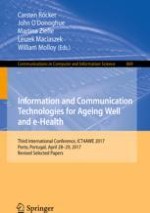2018 | Buch
Information and Communication Technologies for Ageing Well and e-Health
Third International Conference, ICT4AWE 2017, Porto, Portugal, April 28-29, 2017, Revised Selected Papers
herausgegeben von: Prof. Dr. Dr. Carsten Röcker, John O’Donoghue, Prof. Dr. Martina Ziefle, Leszek Maciaszek, William Molloy
Verlag: Springer International Publishing
Buchreihe : Communications in Computer and Information Science
